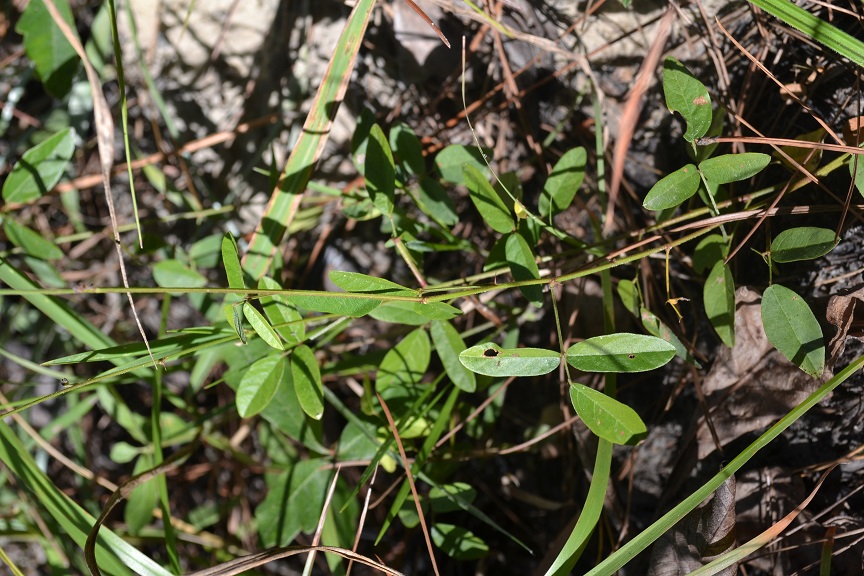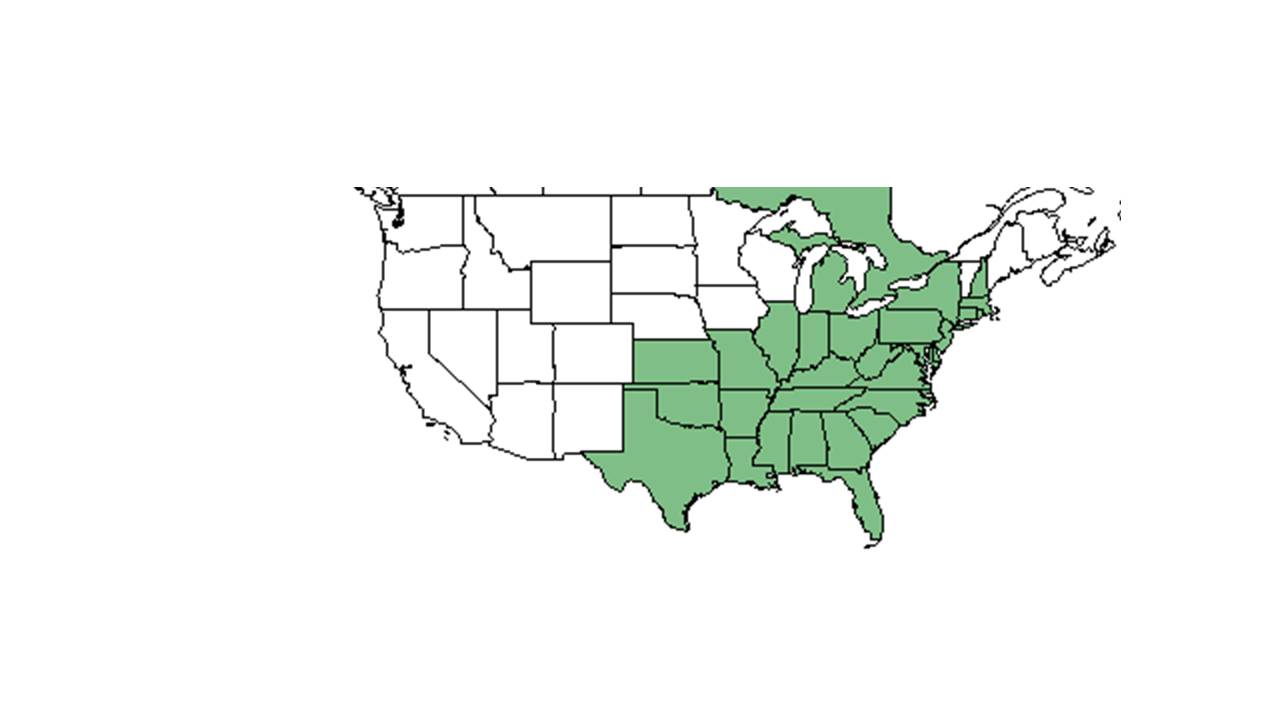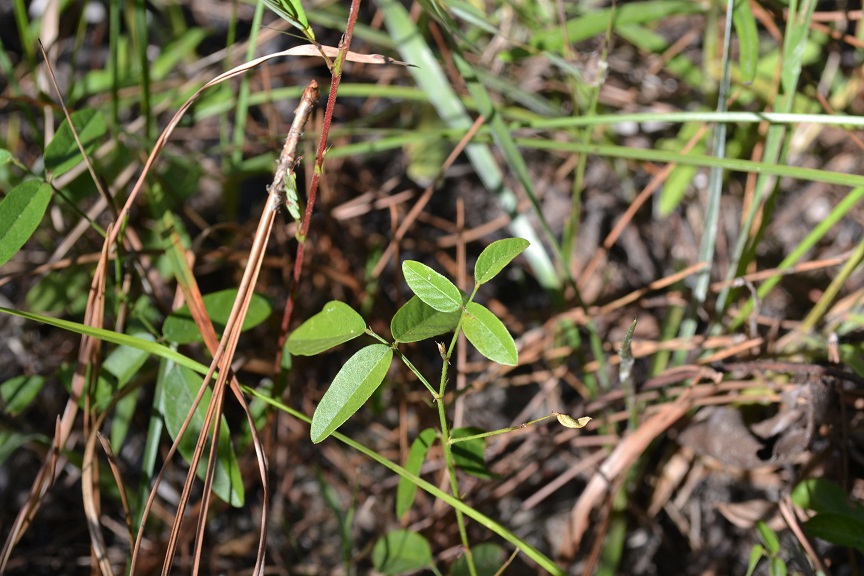Desmodium marilandicum
| Desmodium marilandicum | |
|---|---|

| |
| Photo taken by Kevin Robertson | |
| Scientific classification | |
| Kingdom: | Plantae |
| Division: | Magnoliophyta - Flowering plants |
| Class: | Magnoliopsida – Dicotyledons |
| Order: | Fabales |
| Family: | Fabaceae ⁄ Leguminosae |
| Genus: | Desmodium |
| Species: | D. marilandicum |
| Binomial name | |
| Desmodium marilandicum (L.) DC. | |

| |
| Natural range of Desmodium marilandicum from USDA NRCS Plants Database. | |
Common name: Smooth Small-leaf Tick-trefoil; Maryland Tick-trefoil
Contents
Taxonomic notes
Synonym: Meibomia marilandica (Linnaeus) Kuntze
Description
Generally, for Desmodium genus, they are "annual or perennial herbs, shrubs or small trees. Leaves 1-5 foliolate, pinnately 3-foliolate in ours or rarely the uppermost or lowermost 1-foliolate; leaflets entire, usually stipellate; stipules caduceus to persistent, ovate to subulate, foliaceous to setaceous, often striate. Inflorescence terminal and from the upper axils, paniculate or occasionally racemose; pedicel of each papilionaceous flower subtended by a secondary bract or bractlet, the cluster of 1-few flowers subtended by a primary bract. Calyx slightly to conspicuously 2-lipped, the upper lip scarcely bifid, the lower lip 3-dentate; petals pink, roseate, purple, bluish or white; stamens monadelphous or more commonly diadelphous and then 9 and 1. Legume a stipitate loment, the segments 2-many or rarely solitary, usually flattened and densely uncinated-pubescent, separating into 1-seeded, indehiscent segments." [1]
Specifically, for D. marilandicum species, they are "erect perennial; stems 0.6-1.5 m tall, glabrous or sparsely uncinulate-puberulent and short-pubescent, but never pilose. Terminal leaflets ovate to suborbicular or oblong to elliptic, 1-2.5 (5) cm long, usually 1.6-2.2 as long as wide, both surfaces glabrous to moderately short-pubescent especially on the calyx lobes; petals purplish, 4-6 mm long; stamens diadelphous. Loment of 1-3 weekly obovate segments, each 3.5-5.5 mm long, 3-4 mm broad, slightly convex to almost straight along the upper suture; stipe 1.5-2.5 mm long, equaling or shorter than the calyx and exceeded by the stamina remnants." [1]
Distribution
D. marilandicum is native to the United States from Massachusetts west to Michigan and Missouri and south to Texas and north peninsular Florida.[2] It is also native to Ontario province in Canada.[3]
Ecology
Habitat
Generally, this species can be found in woodland borders, fields, and disturbed areas.[2] Habitats that D. marilandicum has been observed in include pine-oak-hickory woodlands, open, upland pine, dry ridges, and sandhills. Can occur in disturbed areas such as woodlands bordering the road, clearing in a live-oak woodland, clearing between pineland and field, edge of mixed woods around a campground, sterile hillside, and abandoned fields. Requires semi-shaded to open areas. Grows in loamy sand and clayey soil types.[4]
Associated species: Desmodium strictumm, Pinus palustris, Aristida sp., and others.[4]
Phenology
D. marilandicum flowers from June to September, and fruits from June to September.[2] It has been observed flowering from August through October with peak inflorescence in October; and fruiting from September through November.[4][5] The fruit is dry but does not split open when ripe.[6]
Seed dispersal
This species is thought to be dispersed by translocation on animal fur or feathers. [7]
Fire ecology
It can withstand areas with annual burns and winter burns.[4]
Pollination
A short tongued bee Calliopsis andreniformis has been observed on D. marilandicum.[8]
Conservation and management
D. marilandicum is listed as endangered by the New Hampshire Natural Heritage Inventory, Division of Forests and Lands.[3]
Cultivation and restoration
For restoration, D. marilandicum can be planted along with other native forb species to restore longleaf pine-wiregrass savanna herbaceous vegetation.[9]
Photo Gallery
References and notes
- ↑ 1.0 1.1 Radford, Albert E., Harry E. Ahles, and C. Ritchie Bell. Manual of the Vascular Flora of the Carolinas. 1964, 1968. The University of North Carolina Press. 604-10. Print.
- ↑ 2.0 2.1 2.2 Weakley, A. S. (2015). Flora of the Southern and Mid-Atlantic States. Chapel Hill, NC, University of North Carolina Herbarium.
- ↑ 3.0 3.1 USDA, NRCS. (2016). The PLANTS Database (http://plants.usda.gov, 26 April 2019). National Plant Data Team, Greensboro, NC 27401-4901 USA.
- ↑ 4.0 4.1 4.2 4.3 Florida State University Robert K. Godfrey Herbarium database. URL: http://herbarium.bio.fsu.edu. Last accessed: June 2014. Collectors: Loran C. Anderson, R. K. Godfrey, V. Sullivan, J. Wooten, A. F. Clewell, R. Kral, R. Komarek, T. MacClendon, - Boothes; K. Blum, Norlan C. Henderson, John W. Thieret, H. R. Reed, Delzie Demaree, A. C. Mathews, A. E. Radford, G. W. Parmelee, and H. A. Wahl. States and Counties: Alabama: Cleburne, Franklin, and Russell. Arkansas: Drew. Florida: Jackson and Leon. Georgia: Baker and Decatur. Indiana: Elkhart. Louisiana: Morehouse and Natchitoches. Michigan: Barry. Mississippi: Pearl River. Missouri: Henry. North Carolina: Orange and Surry. Pennsylvania: Venango. Virginia: Montgomery.
- ↑ Nelson, G. PanFlora: Plant data for the eastern United States with emphasis on the Southeastern Coastal Plains, Florida, and the Florida Panhandle. www.gilnelson.com/PanFlora/ Accessed: 26 APR 2019
- ↑ [[1]]Accessed: April 21, 2016
- ↑ Kirkman, L. Katherine. Unpublished database of seed dispersal mode of plants found in Coastal Plain longleaf pine-grasslands of the Jones Ecological Research Center, Georgia.
- ↑ [[2]]Encyclopedia of Life. Accessed: April 21, 2016
- ↑ Aschenbach, T. A., et al. (2010). "The initial phase of a longleaf pine-wiregrass savanna restoration: species establishment and community responses." Restoration Ecology 18(5): 762-771.
